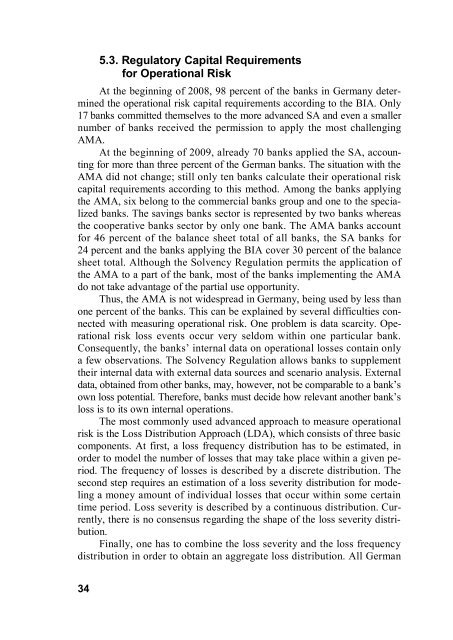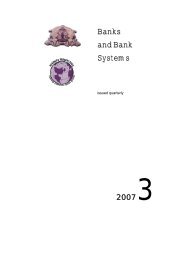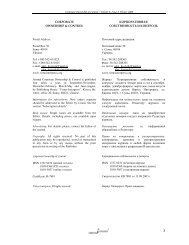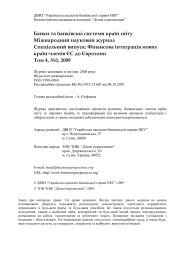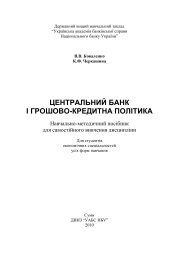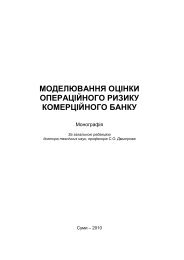BASEL II: PROBLEMS AND USAGE
BASEL II: PROBLEMS AND USAGE
BASEL II: PROBLEMS AND USAGE
Create successful ePaper yourself
Turn your PDF publications into a flip-book with our unique Google optimized e-Paper software.
5.3. Regulatory Capital Requirements<br />
for Operational Risk<br />
At the beginning of 2008, 98 percent of the banks in Germany determined<br />
the operational risk capital requirements according to the BIA. Only<br />
17 banks committed themselves to the more advanced SA and even a smaller<br />
number of banks received the permission to apply the most challenging<br />
AMA.<br />
At the beginning of 2009, already 70 banks applied the SA, accounting<br />
for more than three percent of the German banks. The situation with the<br />
AMA did not change; still only ten banks calculate their operational risk<br />
capital requirements according to this method. Among the banks applying<br />
the AMA, six belong to the commercial banks group and one to the specialized<br />
banks. The savings banks sector is represented by two banks whereas<br />
the cooperative banks sector by only one bank. The AMA banks account<br />
for 46 percent of the balance sheet total of all banks, the SA banks for<br />
24 percent and the banks applying the BIA cover 30 percent of the balance<br />
sheet total. Although the Solvency Regulation permits the application of<br />
the AMA to a part of the bank, most of the banks implementing the AMA<br />
do not take advantage of the partial use opportunity.<br />
Thus, the AMA is not widespread in Germany, being used by less than<br />
one percent of the banks. This can be explained by several difficulties connected<br />
with measuring operational risk. One problem is data scarcity. Operational<br />
risk loss events occur very seldom within one particular bank.<br />
Consequently, the banks’ internal data on operational losses contain only<br />
a few observations. The Solvency Regulation allows banks to supplement<br />
their internal data with external data sources and scenario analysis. External<br />
data, obtained from other banks, may, however, not be comparable to a bank’s<br />
own loss potential. Therefore, banks must decide how relevant another bank’s<br />
loss is to its own internal operations.<br />
The most commonly used advanced approach to measure operational<br />
risk is the Loss Distribution Approach (LDA), which consists of three basic<br />
components. At first, a loss frequency distribution has to be estimated, in<br />
order to model the number of losses that may take place within a given period.<br />
The frequency of losses is described by a discrete distribution. The<br />
second step requires an estimation of a loss severity distribution for modeling<br />
a money amount of individual losses that occur within some certain<br />
time period. Loss severity is described by a continuous distribution. Currently,<br />
there is no consensus regarding the shape of the loss severity distribution.<br />
Finally, one has to combine the loss severity and the loss frequency<br />
distribution in order to obtain an aggregate loss distribution. All German<br />
34


